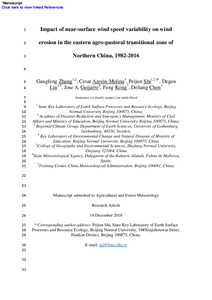Por favor, use este identificador para citar o enlazar este ítem:
http://hdl.handle.net/20.500.11765/12180
Impact of near-surface wind speed variability on wind erosion in the eastern agro-pastoral transitional zone of Northern China, 1982–2016
| Título : | Impact of near-surface wind speed variability on wind erosion in the eastern agro-pastoral transitional zone of Northern China, 1982–2016 |
| Autor : | Zhang, Gangfeng; Azorín Molina, César; Shi, Peijun; Lin, Degeng; Guijarro Pastor, José Antonio


|
| Palabras clave : | Wind erosion; Wind stilling; Northern China; Equation model |
| Fecha de publicación : | 2019 |
| Editor: | Elsevier |
| Citación : | Agricultural and forest meteorology. 2019, 271, p. 102-115 |
| Versión del editor: | https://dx.doi.org/10.1016/j.agrformet.2019.02.039 |
| Resumen : | Wind erosion in arid and semi-arid areas is an important global environmental issue, and changes in wind speed trends over time play a key role in wind erosion dynamics. In a warming climate, scientists have recently observed a widespread decline in wind speed, termed “stilling”. Here, we apply the Revised Wind Erosion Equation Model (RWEQ) to simulate the variability of wind erosion and quantify the impact of wind speed changes on soil degradation dynamics over the eastern agro-pastoral transitional zone of Northern China from 1982 to 2016. Our results show that a significant (i.e., p < 0.05) decrease (-0.007 m s−1 year−1) of near-surface wind speed was observed annually, with significant declining trends in spring (-0.010 m s−1 year−1)and autumn (-0.009 m s−1 year−1). At the same time, wind erosion simulations reveal a negative trend for the annual soil loss from wind erosion (-6.20 t hectare-2 year -1, p < 0.05; affecting 99.8% of the study region), with significant declining trends in all seasons, particularly in spring (-3.49 t hectare-2 year−1) and autumn (-1.26 ha-2 year−1). Further, we isolate the effects of wind variability on wind erosion from 1982 to 2016 by the model variable control method. This shows that wind speed variability strongly weakens wind erosion at -8.14 t hectare-2 year -1 (p < 0.05) annually, with the strongest stilling recorded in spring leading to major decreases of wind erosion in spring (-4.77 t hectare-2 year−1, p < 0.05). Meanwhile, the weakest stilling in summer had the opposite influence on wind erosion (+0.40 t hectare-2 year -1, p < 0.10). To summarize, our findings have shown a significant impact of wind stilling on the decline of soil erosion rates in Northern China. |
| Patrocinador: | This study is supported by the National Natural Science Foundation of China (Grant Nos. 41621061, 41271286), the National Key Research and Development Program–Global Change and Mitigation Project (Grant No. 2016YFA0602404), and the European Union’s Horizon 2020 research and innovation program under the Marie Skłodowska-Curie grant agreement No. 703733 (STILLING project). This work has been also supported by the Swedish Research Council (VR 2017-03780) and the Swedish Foundation for International Cooperation in Research and Higher Education (STINT CH2015-6226). |
| URI : | http://hdl.handle.net/20.500.11765/12180 |
| ISSN : | 0168-1923 1873-2240 |
| Colecciones: | Artículos científicos 2019-2022 |
Ficheros en este ítem:
| Fichero | Descripción | Tamaño | Formato | ||
|---|---|---|---|---|---|
| zhangG19-post.pdf | 2,81 MB | Adobe PDF |  Visualizar/Abrir |
Los ítems de Arcimis están protegidos por una Licencia Creative Commons, salvo que se indique lo contrario.





